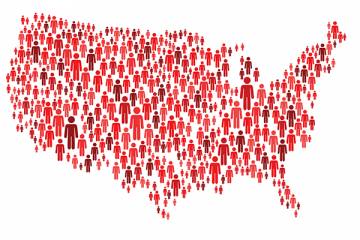Contact tracing is routine practice for many U.S. health departments, which have relied on the strategy for years to control the spread of infectious diseases such as tuberculosis and syphilis. The COVID-19 crisis, however, has created an unprecedented need for contact tracing across the country, requiring thousands of volunteers and new hires.
To that end, the Johns Hopkins Bloomberg School of Public Health volunteers have pitched in to help Baltimore City and the state of Maryland with contact tracing phone calls, while also planning broader training to prepare workers nationwide for the task. The latter involves developing a new Coursera class that will offer certification for new contact tracers.
Leading these efforts are Bloomberg faculty and students involved with SORT, the Surveillance Outbreak and Response Team, including associate scientist Emily Gurley.

Image caption: Emily Gurley
Image credit: Will Kirk / Johns Hopkins University
"Contact tracing is a critical public health tool we need right now in order to limit community transmission of COVID-19," says Gurley, a professor of epidemiology with a background in outbreak response. "We have to identify people who have infections, then identify everyone who they may have possibly infected—then ask all of those people to stay home to protect others."
There's also a larger goal: Widespread contact tracing is seen as a necessary precursor for communities to reduce social distancing mandates and resume shades of normalcy. "The hope is that we can eventually ease back some of these restrictions and allow people to go back to work and lead a slightly more normal life, but that's safer in the context of strong contact tracing and testing," says Forrest Jones, a PhD student involved in SORT.
COVID-19 contact tracing tends to focus on identifying those who have had recent close interactions with a person diagnosed with the disease, such as those who share households or regular activities. Contact tracers typically call these people to explain COVID-19 in detail and ask them to self-quarantine—remaining at home and out of any public circulation—for 14 days since their last exposure. They also try to ensure that each person has the right environment and resources to go through the steps of the quarantine, such as delivery help for groceries or medication.
In Baltimore, SORT has recruited and trained 20 Hopkins-affiliated volunteers to help the city health department with COVID-19 contact tracing, according to PhD student Brooke Jarrett, who has led that effort with classmates Kyu Han Lee and Jowanna Malone.
For the Maryland Department of Health, seven volunteers from SORT have helped reach contacts of those diagnosed with COVID-19 across multiple counties, says Jones, who is in charge of that angle.
Both the city and state volunteers from Hopkins have made more than 800 phone calls so far, with each volunteer devoting about 10 hours per week to the cause.
Meanwhile, Gurley and others at SORT are developing a new Coursera class to provide future contact tracers with background on the public health strategy as well as information on COVID-19. Training modules will explore how the disease is transmitted and how contact tracing works to reduce infection, along with ethical considerations and best practices for interviews. After passing the online class, expected to be four or five hours long, the student will earn a certificate in contact tracing.
"Because of the huge need right now, many of these people who are going to become contact tracers likely don't have a background in infectious diseases or public health," Gurley says. "So we want to make sure that everybody has the same knowledge base and is ready to absorb the material about specific case investigation and contact tracing protocols once they get to the specific health department where they'll be working."
According to Gurley, the Coursera class is slated for release within the next few weeks, and it will be open to the public.
Part of the impetus for the course is the massive contact tracing program in New York recently launched by Johns Hopkins alum and former New York City Mayor Michael Bloomberg and New York Gov. Andrew Cuomo, which involves support from the Bloomberg School. But Gurley emphasizes that the training materials will be relevant to any city or state health department.
Jarrett, who is also involved in that effort, notes that contact tracing requires not only specific training on the practice but also certain sensitivities and skills in personal engagement. "It's about making that human connection and saying, 'I'm here to check up on you,'" she says. "People have to trust you and recognize that you're not just there to collect data from them. This is about keeping the larger community safe, and also part of the larger hope that we're eventually going to dig ourselves out of the current situation."
To stay up to date on the Coursera contact training program and other Bloomberg School of Public Health COVID-19 initiatives, please subscribe to the school's Daily Roundup newsletter. If you're seeking more information about New York's Contact Tracing Program, please email ContactTracing@Bloomberg.org. If you're interested in learning more about contact tracing in your area, please contact your local or state health department to find out about regional tracer programs.
Posted in Health
Tagged baltimore, school of public health, coronavirus, covid-19











